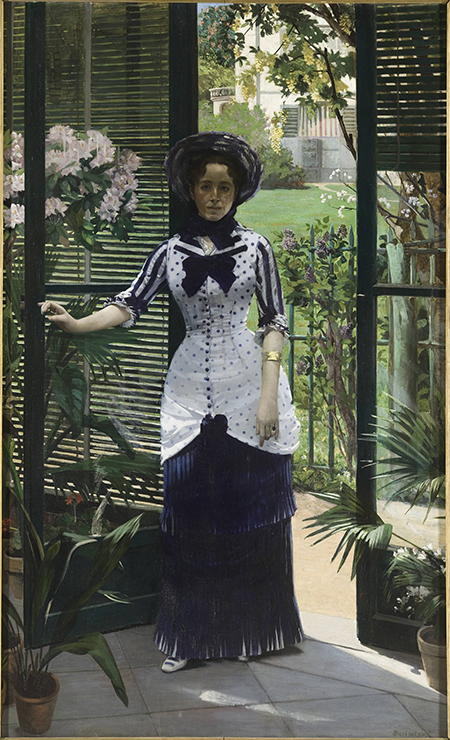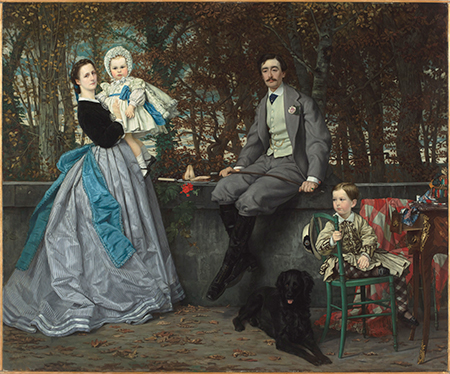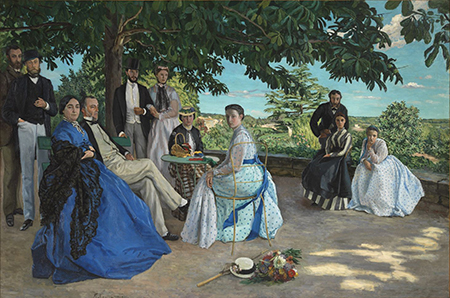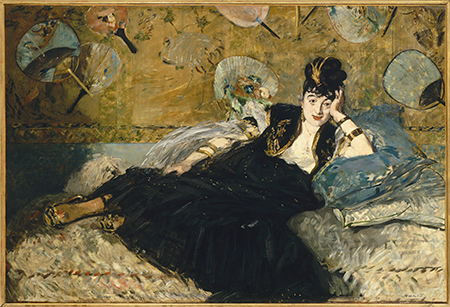“I long for the return of dioramas whose enormous, crude magic subjects me to the spell of a useful illusion,” lamented Charles Baudelaire in his review of the annual art Salon in Paris in 1859. He added, “I prefer looking at the backdrop paintings of the stage where I find my favorite dreams treated with consummate skill and tragic concision. Those things, so completely false, are for that very reason much closer to the truth, whereas the majority of our landscape painters are liars, precisely because they fail to lie.”
- “Impressionism, Fashion, and Modernity.” Through January 20, 2013. Musee d’Orsay, Paris. February 26 through May 27, 2013. The Metropolitan Museum of Art, New York.
June 26 through September 22, 2013. The Art Institute of Chicago.
Baudelaire’s pointed paradox was a critique of the aesthetic formalism of the mid 19th-century French artists whose paintings often depicted grand scenes of history or myth rendered with a precision that was near photographic. Instead, Baudelaire advocated a kind of painting that was of the moment, not of the past, but rather an art of the present capturing the vitality of the city. The Parisian crowds that filled the boulevards and arcades were the subjects he most appreciated, as well as the increasingly public life of the city played out in the cafes and parks, at cabarets and music halls. Paris of the mid 19th century was becoming a stage for the city’s emerging haute bourgeoisie, and the style of the fashionable Parisienne was as much an invention of the city as its new urban design. Under Baron Haussmann’s hand, Paris was transformed from a maze of medieval streets into grand boulevards lined with plate glass storefronts and elegant balconies. Ornate temples of department stores clustered around the opulent Palais Garnier (or Opera House) that rose with little humility on the Boulevard des Capucines. “Modernity is the transient, the fleeting, the contingent,” Baudelaire famously declared in his long essay “The Painter of Modern Life.” But, like the grey stones of Haussmann’s Paris, this modernity was also paradoxically “eternal” and “immovable.”

“In the Conservatory” (1881)
Baudelaire’s ideas haunt this show at every turn, his words about art and modernity printed across gallery walls, reminding us how much his sense of modernity was linked to fashion itself. As Haussmann was destroying much of Medieval Paris, Baudelaire warned painters to avoid the old masters in matters of fashion:
“The draperies of Rubens or Veronese will not teach you to paint watered silk á l’antique, or satin á la reine, or any other fabric produced by our mills, supported by a swaying crinoline, or petticoats or starched muslin. The texture and grain are not the same as in the fabrics of old Venice, or those worn at the court of Catherine. We may add that the cut of the skirt and bodice is absolutely different, that the pleats are arranged into a new pattern, and finally that the gesture and carriage of the woman of today give her dress a vitality and a character that are not those of the woman of former ages.”
This linking of fashion with modernity draws together a range of artists’ works situated amidst textiles of original dresses, hats, shoes, corsets and petticoats. This exhibition, set for show in New York and Chicago next year, pulls together art and fashion history, but also illuminates something bigger than either. At one moment early in the show you encounter Albert Bartholomé’s “In the Conservatory” (1881), a full-length portrait of his wife captured in the morning light, her dress rendered with rich details, the skirt’s blue pleading and layered design look as if it could sway with elegant ease. There is a subtle repetition between the skirt’s pattern and the palm leaves nearby, suggesting seamless link between a woman’s dress and the beauty of nature. But no need to ponder the dress for long, for next to the painting sits the actual artifact that Madame Bartholomé wore in that painting, preserved over the years such that its colors and textures look as fresh as that morning decades ago. It was somewhat odd to encounter the dress in both its oil paint rendering and its actual material. At each turn in this show textiles and painting echo each other, making the objects and their image nearly the same. Or rather almost the same. “It is not known who made Madame Bartholomé’s fashionable summer dress,” the catalog description tell us, and I was struck by this contrast of creation between the artist who painted the dress and the person who made the actual one. This tension, or rather mystery, between the images of fashion and production of the artifacts weaves itself throughout the show. It too is part of modernity’s legacy.
But the images are what compel us here. The curators have compiled a rich collection of paintings, photographs and textiles that document the invention of a Parisienne. The show begins with lithographs and illustrations from early fashion magazines that offered patterns and guides for small shop owners and clients. But these magazines also fostered a style of dress and tastes that shaped the composure of what fashion should look like. We see copies of these illustrations in the studio portraits of André-Adolphe-Eugène Disdéri and Félix Nadar. A series of Disdéri’s postcard-sized carte de visite, or studio portraits, fill a long wall in the second gallery. They could go unnoticed among the more illuminated displays of hats and shows, but don’t pass them by. Here you encounter some of the earliest popular photography. Women, often standing, stare off in the distance as their billowing skirts stretch across the frame. Men, either seated or standing, display their well-tailored jackets and narrow pants, often a walking stick nearby. The clothing is as much the subject of the photographs as the person. But these are not mere portraits. Rather they were important visual announcements of a certain kind of individualism amidst the crowds of Paris. As much as Baudelaire celebrated the “irresistible passion” and curiosities of the Parisian crowds, these portraits suggest how the middle-classes used the early photographic technologies to define themselves as connoisseurs of taste and style. Those who could afford these photographs would have hundreds printed and use them as calling cards, casting a public image that was highly staged.

“Portrait of the Marquis of Miramon” (1865)
The paintings do their own kind of performance. James Tissot’s “Portrait of the Marquis of Miramon” (1865) presents an outdoor family portrait amidst the fall foliage, Madame Miramon’s skirt and sash flowing with crisp blue hues. Monsieur Miramon sits aloof in his somber gray riding outfit, his son looking royal in his ochre silks. Tissot’s works are dominant in this show both in their lush details and vibrant colors, but also in how they each present a highly stage scene of subjects who seem so desperate to be looked at. This desperation is also seen in Frédéric Bazille’s “Family Reunion” (1867) where a casual day in the park looks more like an actors’ gathering for the promotion of their next stage play. Your eye moves across the canvas following the color of the skirts from the folded sheens of the older lady’s dark blue, to the lighter prints of the younger women to the right. But these paintings distract me, like the mannequins floating around me, for I couldn’t anything else but notice the skirts or the delicacy of the sheer sleeves of the woman in the back, or the striped bodice of the other woman off to the right. You start to wonder how the painter achieved such delicacy with oil on canvas and you forget that this effect, this rendering in all its precise details is really just a beautiful illusion.

“Family Reunion” (1867)
It is not the precision of Tissot or Brazille that reminds you of this illusion, but rather the works by the Impressionists. As these artists did with the streetscapes and landscapes, with the bridges and the facades of buildings, they did with fashion as well: Turning the folds and flow of fabric into hazy filters of light and shadows. Édouard Manet’s “Lady with Fans (Portrait of Nina de Callias)” (1873) transforms the delicate dress, as well as the bedding and pillows she reclines upon, into pure brush strokes. The clothing seems to matter little for Manet, who presents a portrait that makes us aware from our first encounter that this is not a dress, but rather a painting of a dress. The proportions are not right. Her body looks distorted. The bed oddly angled. The woman’s skirt seems to flow into the textures and patterns around her. The painting is as much about a woman and her fans as it is about painting a woman with her fans.

“Lady with Fans” (1873)
We encounter this again and again with Manet and his contemporaries Renoir, Degas and Monet. We see it also in Berthe Morisot, Manet’s sister-in-law (and later his lover). In “On the Balcony” (1872), Morisot presents a woman and child viewed from behind, both subjects looking outward, the city’s building cloudy in the distance. The woman’s black dress and the girls white jumper are rendered with thick brush strokes that defy details or distinction. While the subject for many of these artists were their fashionable patrons, displayed in the silks and muslins of the era, they present us with the luminous sense of fabric more than the particular costume. If anything, the Impressionists give us little insight about fashion, as they show us how fabric itself, like landscapes and street scenes, becomes explorations into color and light, shadows and brushstrokes. Consider a work such as Manet’s “Nana” (1877) which presents a young woman in corset and petticoat, in the midst of getting dressed (or undressed), who stares directly at us as an older man in evening attire sits off to the side, half out of the painting’s frame. As much as this painting unsettled Manet’s viewers in its subject matter, it is also a work consciously aware of itself as a painting, as a partial view, a distorted scene that continues beyond the frame. The oil paintings, like the ornaments of dress, project their own unique illusion.
This idea is made clear in two lavishly red galleries that are ringed with petite golden backed chairs, each labeled with the name of a Parisian socialite of the era. In the center of the room, the paintings were hung on three parallel walls, creating a space that was more fashion runway than art gallery. But this was the point. Here we encounter Manet’s captivating “The Parisienne” (1875) on one wall, its dark canvas presenting a woman layered in dark fabrics, an umbrella in one gloved hand and wearing a silk hat arched to the right. A mysterious light radiates behind her that both emphasizes the tight waist silhouette as much as it casts a shimmering glow to the portrait. Her aloof stance compels us to wonder if she is a respectable lady of Parisian society, or a more questionable courtesan, or simply a woman alone. Her dress reveals as much as it conceals, and Manet knew this well.
On another wall you encounter Renoir’s version of the Parisienne, her demeanor less haunted than Manet’s but still the light radiates from behind her, turning the folds and sheen of her layered blue skirts into a play of light and shadows, the figure nearly floating in a gray space that, like Manet’s canvas, conjures more questions than answers. But as you turned around from these paintings, you confronted your own image, reflected in mirrors that filled the opposite wall of each painting. The portraits reflected in a mirror only enhanced the illusion each image presents in their brushstrokes and mysterious light. But another effect was to see yourself within the very frame of the painting, your image transfixed upon the canvas. It provoked an oddly intriguing moment when the painting became something to try on, something to wear, something to see yourself in. How strange, I thought, that we move from displays of clothing pictured in the painting, to the painting as its own form of imagined dress.
Throughout the show what is absent are Impressionist paintings depicting shopping or the social life of the grand department stores that were emerging as an alluring facet of the city as much as the Opera or cafes or even the dance halls—each playing a backdrop in works here. For many painters (Degas being one exception) the displays of fashion overshadowed the consumption of it. While the painters might have ignored such modern moments, the writers were more intrigued by it. Emile Zola’s set his novel, “Lady’s Paradise” in an imagined department store in the 1860s. The protagonist Jean Baudu arrives young and jobless from Normandy, and, on her walk from the train station, encounters the attractive opulence of objects in the plate glass windows that advertise the Ladies’ Paradise. Inside Jean enters a “chapel built for the worship of woman’s beauty and grace” filled with such items as “a velvet coat trimmed with silver fox” or “a cloth overcoat edged with cock’s feathers” or “evening wraps in white cashmere and white quilting, decorated with swans down or chenille.” Beyond the items themselves, Baudu was in awe with the near dizzying ambience of the department store:
“There was something for every whim, from evening wraps at twenty-nine francs to the velvet coat priced at eighteen hundred francs. The dummies’ round bosoms swelled out the material, their hips exaggerated the narrow waits, and their missing heads were replaced by large price tags with pins stuck through them into the red bunting round the collars, while mirrors on either side of the windows had been skillfully arranged to reflect the dummies, multiplying them endlessly, seeming to fill the street with these beautiful women for sale with huge price tags where their heads should have been.”
It is this illusion that Jean finds so attractive and so haunting, and ultimately so exhausting in her work as a salesgirl at the Ladies’ Paradise.
The final gallery offers its own kind of artificial paradise. The brightly lit space is a reproduction of an outdoor garden, complete with fake grass, park benches and birdsong where Monet’s large unfinished panels of “Luncheon on the Grass” (1865-66) are displayed next to a number of summer dresses. Wandering the garden, you become aware how much this show evolves (or devolves) into surfaces. This too is the story of modernity. But such surfaces are not simply stage-like. Rather they offer that “unique illusion” that Baudelaire wrote of back in 1859. The kind of illusions that holds in them a paradox of truth: Fashion as its own kind of consuming chimera of modernity. This is what the Impressionists challenge us to see in their canvases, this play of light and paint to create paintings that remind us they are indeed paint on a canvas. Their paintings were a constant challenges to the way we see, the ways we understood the tangible realities around us; and, as the curators seem to suggest here, so too does fashion. The show is best when it makes us aware of this, when it doesn’t get lost in the celebration of fabrics and lace corsets and bonnets and shoes (it is sponsored by Chanel and Louis Vuitton after all). It is most intriguing when it asks us to see beyond the allure and textures of the headless dresses, towards a history of a modernity caught in a paradox of illusion and truth. • 13 December 2012




